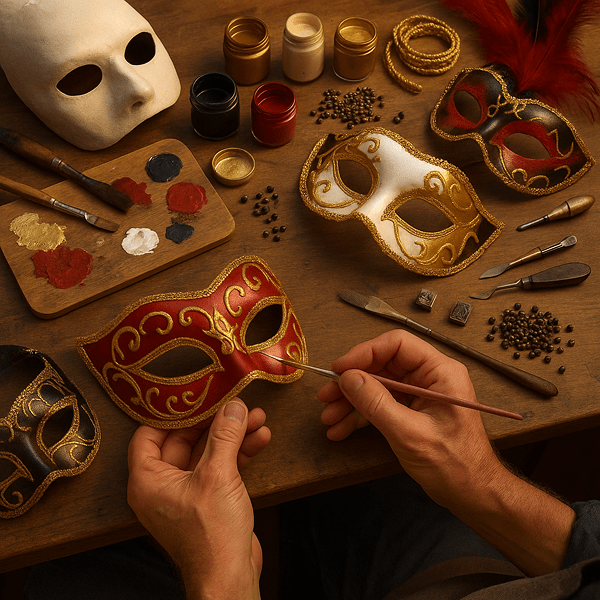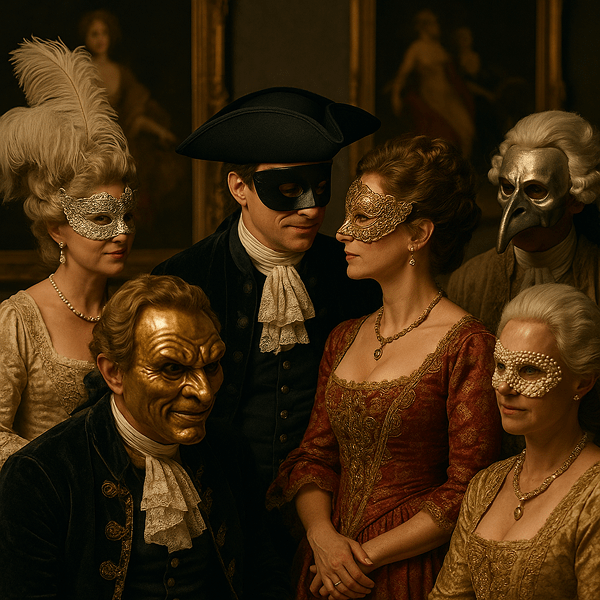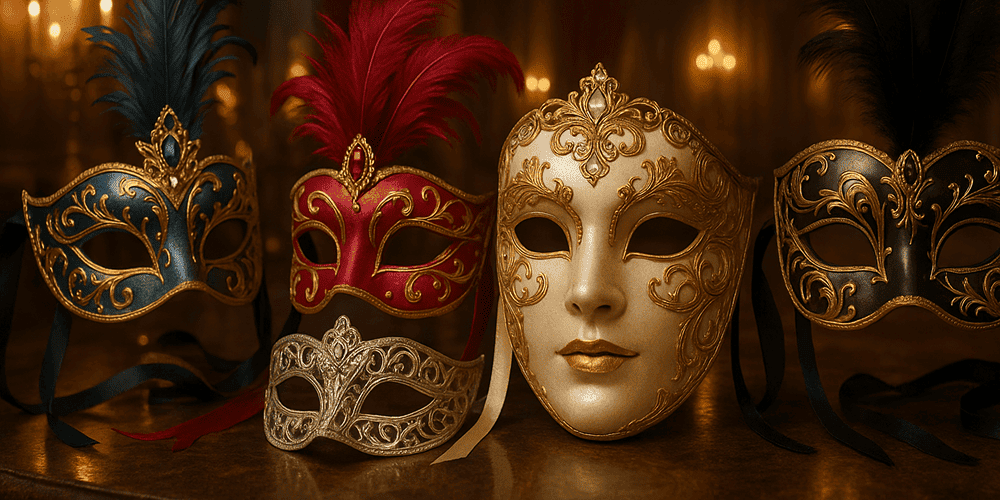Masquerade Ball Masks — also known as Ball Masks or Masquerade Masks — are elegant, enigmatic accessories that have been central to the pageantry and mystique of masked balls for centuries. Instantly recognizable for their ornate ornamentation, vibrant colors, and mysterious allure, Masquerade Ball Masks are designed to conceal the wearer’s identity while highlighting their style and status. Most commonly associated with grand European masquerades of the Renaissance and Baroque periods, these masks feature striking forms such as the half-face Colombina, the full-face Bauta, intricate eye-masks, and elaborate feathered designs. Today, Masquerade Ball Masks are celebrated worldwide as symbols of transformation, intrigue, and festive artistry.
Historical Origins of Masquerade Ball Masks
The origins of Masquerade Ball Masks trace back to the opulent courts of Renaissance Italy, particularly Venice, where masked balls became a cornerstone of aristocratic and civic life. The term “masquerade” derives from the Italian “mascherata,” meaning a masked entertainment or pageant. Initially, masks were used in religious festivals and public celebrations, but by the 16th and 17th centuries, they became essential to courtly balls, theatrical performances, and diplomatic gatherings.
The evolution of Ball Masks mirrored the changing fashions and social mores of Europe. Early masks were simple and functional, providing anonymity for all social classes. By the Baroque era, masks became increasingly ornate, adorned with gold leaf, lace, jewels, and feathers. Famous historical references include descriptions of lavish masked balls at Versailles, the Viennese court, and the English aristocracy. Surviving artifacts, such as antique masks in European museums, document the transformation of Masquerade Ball Masks from ritual objects to high art.
Cultural Significance and Symbolism of Masquerade Ball Masks
Masquerade Ball Masks are rich in symbolic meaning. In their native cultures, these masks represented freedom, anonymity, and the subversion of social boundaries. The act of donning a mask allowed individuals to explore alternate identities, engage in playful flirtation, and critique authority without fear of reprisal.
Spiritually, the mask was often seen as a mediator between the mundane and the magical. Myths and legends abound — from masked lovers escaping the constraints of society, to tales of intrigue, betrayal, and forbidden romance at masquerade balls. In literature and art, Masquerade Ball Masks are frequently used to symbolize transformation, duality, and the tension between appearance and reality.
Socially, the mask enabled people of different classes and backgrounds to mingle on equal terms. The masquerade ball became a space for social experimentation, satire, and the temporary suspension of everyday rules — a tradition that continues to inspire fascination today.
Materials and Crafting Techniques of Masquerade Ball Masks
Traditional Masquerade Ball Masks are crafted from a variety of materials, reflecting both regional resources and evolving fashion. The most common materials include papier-mâché, leather, velvet, and sometimes porcelain or metal. Artisans begin by sculpting a mold, then layering and shaping the base material to form the desired structure.
After the basic form is achieved, the mask is dried, sanded, and hand-finished. Decorative techniques include painting, gilding, embossing, and the addition of lace, beads, sequins, feathers, and gemstones. Brushes, carving tools, palette knives, and stamps are used to achieve intricate designs. In Venice, for example, the ancient guild of maschereri developed distinctive methods and regional characteristics. Color symbolism is central: gold and silver denote luxury, black represents mystery, red signifies passion, and white is purity. Each mask is a unique work of art, reflecting the creativity of its maker.
For more about mask-making traditions and artisan interviews, see the extensive guides on toddmasks.com.

Functions and Uses of Masquerade Ball Masks
Masquerade Ball Masks have served a wide array of functions across history. Their primary role was in grand balls and masquerade galas, where masks provided anonymity, excitement, and an atmosphere of enchantment. Masks also played key roles in theatrical performances, particularly in the Italian commedia dell’arte, where stock characters wore distinctive masks to signal their identity and status.
Over time, the use of Ball Masks expanded to include public festivals, civic celebrations, and private parties. In some regions, masks were used in religious or ritual contexts, while in others they became fashion statements or collectible items. Today, Masquerade Ball Masks are worn at themed parties, weddings, Mardi Gras parades, and cultural festivals around the world — adapting to modern tastes while retaining their historic charm.
Regional Variations of Masquerade Ball Masks
While the Venetian tradition is the most famous, Masquerade Ball Masks have developed unique regional styles across Europe and beyond. In France, the “bal masqué” featured elegant eye-masks and powdered wigs, while in England, Georgian masquerades popularized minimalistic domino masks. Austrian and German masked balls favored ornate, often animal-themed designs.
Regional differences often reflected local materials, available resources, and aesthetic preferences. For example, Venetian masks are noted for their elaborate decoration and use of gold leaf, while Swiss and German masks may feature wood carving or folk motifs. Comparing Masquerade Ball Masks to similar traditions, such as the masks of Carnival Masks or the elaborate disguises of Latin American festivals, reveals both common roots and culturally specific adaptations.
Famous Examples and Collections of Masquerade Ball Masks
Many famous Masquerade Ball Masks are preserved in museums and private collections around the world. The Victoria and Albert Museum in London, Musée Carnavalet in Paris, and the Museo di Palazzo Mocenigo in Venice all house historic masks, costumes, and documents related to the masquerade tradition.
Notable artifacts include 18th-century Bauta and Columbina masks, gem-encrusted masks from royal courts, and theatrical pieces from commedia dell’arte. Private collectors often loan rare masks to international exhibitions. For online viewing and expert commentary, toddmasks.com provides curated galleries and in-depth articles on the provenance and artistry of Ball Masks.
Influence of Masquerade Ball Masks on Art and Culture
The impact of Masquerade Ball Masks on art and culture is profound. Their dramatic and evocative forms have inspired countless painters, sculptors, and designers — from the masked figures in the works of Watteau and Fragonard, to the surrealist imagery of Picasso and Magritte. In literature, masked balls feature in classics like “The Masque of the Red Death” by Edgar Allan Poe and “Casanova’s Memoirs.”
In music and opera, masked balls provide the setting for intrigue and romance, most famously in Verdi’s “Un ballo in maschera.” Contemporary fashion and design continue to reference Ball Masks, with haute couture houses and theatrical productions regularly incorporating their motifs. The preservation and celebration of Masquerade Ball Masks are vital to maintaining cultural heritage and inspiring new creative directions.

Contemporary Status and Preservation of Masquerade Ball Mask Tradition
Today, the tradition of Masquerade Ball Masks is alive and flourishing. Master artisans in Europe and around the world continue to produce masks using both traditional and innovative techniques. Schools and workshops — especially in Venice and Paris — offer training in mask-making, design, and decoration.
Preservation efforts include museum exhibitions, educational programs, and cultural festivals. Modern adaptations feature eco-friendly materials, digital design, and interactive elements, ensuring the tradition’s continued relevance. Organizations like toddmasks.com play a key role in promoting mask culture, hosting masterclasses, and providing resources for enthusiasts and makers.
Collecting and Acquiring Masquerade Ball Masks
The market for Masquerade Ball Masks ranges from affordable party masks to rare and valuable collector’s items. Authentic masks can be found in artisan workshops, reputable galleries, auction houses, and trusted online platforms such as toddmasks.com. Prices vary according to material, provenance, artistic quality, and historical significance.
To identify genuine Ball Masks, collectors should look for artisan signatures, traditional materials, and careful craftsmanship. Documentation and provenance enhance value, while mass-produced or plastic masks are generally less sought after. Ethical collecting involves supporting living artisans, respecting cultural traditions, and avoiding counterfeit or culturally sensitive items. Toddmasks.com offers expert guidance on authenticity, valuation, and responsible collecting.
The Timeless Significance of Masquerade Ball Masks
Masquerade Ball Masks are more than decorative accessories — they are powerful symbols of transformation, artistry, and social freedom. Their history weaves together ritual, spectacle, and personal expression. Today, these masks continue to enchant and inspire, bridging the gap between past and present. With ongoing support from artisans, collectors, and educational platforms like toddmasks.com, the tradition of Masquerade Ball Masks will remain vibrant and relevant for generations to come.
